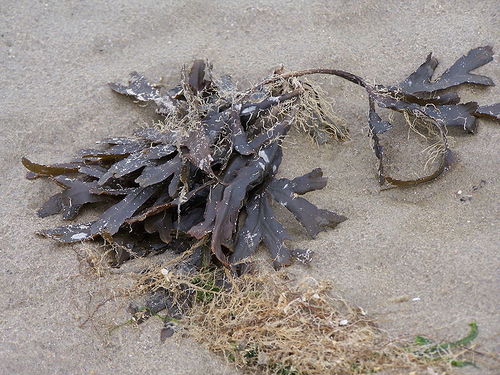Algae
Algae are a useful first step in many designed, productive ecosystems. They are easily grown in nearly any body of water. They can be applied to several purposes.
microalgae: small microscopic aquatic photosynthetic plants that require the aid of a microscope to be seen (examples: chlorella, spirulina)
macroalgae: large aquatic photosynthetic plants that can been seen without the aid of a microscope (example: kelp)
Spirulina as a food source for humans
Spirulina is an extremely nutritious microalga that can be grown on a small scale. I've never met anyone who likes the taste of it, but it can be ground up with avocados or pesto or other things to mask the taste. Spirulina grows in long spiral chains that can be easily harvested in a cloth. It grows in highly alkaline water with a pH of 8-11.
- Full instructions for how to grow your own spirulina can be found here. 100g/day/4m2
- Other small-scale examples are in Auroville, India, which pioneered spirulina farming. Informative page with details of their operation: [1]
- There is another Indian small-scale example in Madurai (video here) - 150g/day/20m2
- Some successful village-scale examples in West Africa. But all of these are rather labor intensive.
- Gunter Pauli of ZERI did an interesting integration project in Namibia: Spirulina and Beer! - also see this Yes Magazine article. Basically, brewery wastewater which is highly alkaline, is used for growing spirulina. This eliminates cost for many chemicals, takes harmful alkaline wastewater out of the waste stream and turns it into something useful (waste-to-resource). The spent grains from brewery barley are first used to grow mushrooms, then leftovers are put into a biogas digester. Biogas powers the brewery. It's ingenious.
- There is one patent about growing your own Spirulina at home in a photobioreactor.
- Contamination doesn't seem to be such an issue with Spirulina because of the highly alkaline pH; nothing much else will grow at pH 10.5.
- Intergovernmental Institution for the use of micro-algae Spirulina against Malnutrition (IIMSAM) [2], which includes an overview of different production systems.
- Jean-Paul Jourdan of France is a pioneer for small-scale spirulina cultivation in temperate climates.
Multiples uses
- Algae as a food source for fish: Aquaponics turns algae into edible fish
- Algae as a food source for plants: Some species of algae, like maerl and bull kelp, can be used to fertilize plants
- Algae as a fuel: The carbon-based compounds produced by some algae can be used as fuel
Algae as a fertilizer
Algae can be used to capture fertilizers in runoff from farms. When subsequently harvested, the enriched algae itself can be used as fertilizer. Agricultural Research Service scientists found that 60-90% of nitrogen runoff and 70-100% of phosphorus runoff can be captured from manure effluents using an algal turf scrubber (ATS). Scientists developed the ATS, which are shallow, 100-foot raceways of nylon netting where algae colonies can form, and studied its efficacy for three years. They found that algae can readily be used to reduce the nutrient runoff from agricultural fields and increase the quality of water flowing into rivers, streams, and oceans. The enriched algae itself also can be used as a fertilizer. Researchers collected and dried the nutrient-rich algae from the ATS and studied its potential as an organic fertilizer. They found that cucumber and corn seedlings grew just as well using ATS organic fertilizer as they did with commercial fertilizers "Algae: A Mean, Green Cleaning Machine". USDA Agricultural Research Service. May 7, 2010.
Wiki links
More external links
- Algaelab: A community lab in Berkley, CA seeking the development of an open-source/DIY-oriented algae technology
- Vinay says this Algal Turf Scrubber is a promising technology -
- An Algae Bioreactor from Recycled Water Bottles
- Critique: This is a cute puppy show. Quick calculation shows that you will get about 1 gram of algae from the setup under optimal conditions per day, based on empirical data from the Madurai work above. Therefore, if you did this manually to extract fuel, you would use up more calories in your effort than you get out of the fuel. No one has figured out how to do this with economic feasibility for fuel production. What are the efforts closest to success? This is definitely a proposition that could work, but efficient means of algae collection are one of the technical difficulties that one encounters in practice.
- CodysLab experimental prototype algae panel with plastic bottles


